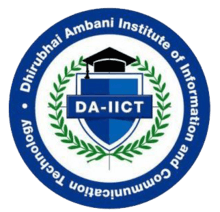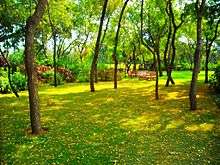Dhirubhai Ambani Institute of Information and Communication Technology
Dhirubhai Ambani Institute of Information and Communication Technology (DA-IICT), is a prestigious private college located in Gandhinagar, Gujarat, India. It is named after the Gujarati entrepreneur and Reliance group founder Dhirubhai Ambani. It is run by the Dhirubhai Ambani Foundation and is promoted by the Anil Dhirubhai Ambani Group.[1]
 | |
| Motto | Knowledge is Leadership |
|---|---|
| Type | Private |
| Established | 2001 |
| President | Anil Ambani |
| Director | K. S. Dasgupta |
| Location | , |
| Website | www |
Academics
DA-IICT began admitting students in August 2001, with an intake of 240 undergraduate students for its Bachelor of Technology (B.Tech.) program in Information and Communication Technology (ICT). Since then, it has expanded to include postgraduate courses such as Master of Technology (M. Tech.) in ICT, Master of Science (M.Sc.) in Information Technology, Master of Science (ICT) in Agriculture and Rural Development, Master in Design (M. Des.) and a Doctor of Philosophy (Ph.D.), a Doctorate program. The duration of the bachelor's program is 4 years. The first batch of DA-IICT post-graduates passed out in 2004 and the first batch of graduates in 2005. Fees is nominal when compared to other private institutions in India.
Admission

.jpg)
Admission is based on Joint Entrance Examination - Main. A few seats are reserved for Non-Residential Indians (NRIs) and Foreign Nationals (FNs), who are admitted through the Direct Admission of Foreign Student (DAFS) channel. Although in recent years NRI quota is now dismissed.
Student achievements
- Team of 2 students from DA-IICT won the GNLU Debate 2016 in the Novice category.
- 17 students from DA-IICT selected for the prestigious Google Summer Of Code, 2013.
- Team DA-Developers represented DA-IICT at the Imagine Cup 2013 National Finals and stood third in India for Imagine Cup World Citizenship contest with their app "Read For Blind".[2]
- Team of 4 students stood 3rd at the National Finals for "Samsung USID Design Challenge", 2012 for their app "Location Alarm".[3]
- 17 students selected for Google Summer of Code, 2012, the highest number in India and third highest in the world.
- A student won Innovate4Women Award of the Microsoft Imagine Cup 2010[4] and One of its team were National Finalist in Microsoft Imagine Cup India.[5]
- Team of 4 students won the Unlimited Potential Multipoint Education Award of the Microsoft Imagine Cup 2009, World Finals.[6] The same team stood 3rd in the National Finals in the Software Design category of the Microsoft Imagine Cup 2009, India Finals
- Two students won Google Women Engineering Award in year 2009 and 2010[7][8]
- Two of its teams were winners at the Microsoft, High Performance Computing Scholars Program 2008[9]
- Teams of four students each won the Microsoft Imagine cup for two consecutive years in 2006 and 2007[10][11][12][13]
- Student teams won the TI DSP Design Competition in 2005, 2006 and 2007[14]
In 2004, three MSc (IT) students of DA-IICT challenged in the Gujarat High Court, the IIMA decision to not offer admission interviews to them citing their eligibility criteria (AIU or AICTE affiliation was needed at that time). The judgement was passed in the favour of students and the CAT eligibility criteria were subsequently modified.[15]
Infrastructure
DA-IICT has a modern, networked campus with optical fibre cable connectivity between buildings. It has IT infrastructure, computing and communication resources, electronic access controls and a payment system through smart cards.
The environment of the institute — a cluster of minimalistic structures in the midst of the trees, shrubs and well-laid out lawns — provides a serene ambience to the campus. The campus has three air-cooled lecture theatres, two with a seating capacity of more than 200 and one with a seating capacity of about 250, with audio and video presentation systems. The classrooms and tutorial rooms are equipped with audio-visual aids and have Internet connectivity.
Utilities and services such as the cafeteria, food courts, ATM, medical centre, campus shop, telephone kiosk, photocopying facility, open-air theatre are on the campus.
Laboratory building
More than 1200 nodes connected via 100 Mbit/s switches and a 1 Gbit/s fiber backbone form the superstructure of the network. Each computer is at least a Pentium IV multi OS, fully connected terminal. Thus ensuring that there is at least one high-end computer available to each student and faculty on the campus.
The laboratory building houses teaching and research laboratories for electronics, communications, computers and networks. More than 800 computers are installed in these laboratories. Students use resources of laboratories (open until midnight) to solve problems, perform developmental experiments and work on projects guided by faculty.
By granting 24 hours lab facility and access to the network from each classroom and lecture theater information is made easily accessible from any point on campus. The students are provided a 16 Mbit/s line for their hostel rooms.
The lab structure is divided as follows:
- Multimedia labs have a main Apple Xserver having a 2.5 terabyte capacity, Apple iMacs, Apple iMate, iBooks (G5) and HP based high-end systems. The software available to students in this lab includes Apple Works, Maya, Adobe Creative Suit, Sony Soundforge Pro, AutoCAD and 3DMax.
- The Grid lab has 20 servers build using a Globus toolkit. This lab is where most of the research into service-oriented computing and distributed computing, especially different grid architectures, take place.
- The Network lab allows students to operate and configure networking equipment like routers, mail/http/name servers, and to use and create wireless networks. There are LAN trainer kits and network simulators.
- VLSI lab consists of three labs: the two main labs have access to the tools required for design and implementation in VLSI including access to Xilinx FPGAs, mentor graphics tools (multi-user licenses) and Cadence tools.
- RF lab consists of RF equipment including three types of spectrum analyzer: Agilent in the range of 3 kHz to 3 GHz, Hameg around 1 GHz and LG within frequency range of 9 kHz to 2.75 GHz. Signal generators from Agilent that are able to operate over the range of 250 kHz – 3 GHz and Network Analyzers are part of the lab. There are CDMA trainers and Antenna training sets.
- English Language lab with Linguaphone and Globarena software. Though the software can be used independently, as there is self-monitoring feed back facility for users, there is provision for Teaching Assistants’ help as an additional resource for the students with language handicaps.
Faculty and administrative block
The Faculty Building Complex consists of four faculty blocks, each with eighteen faculty rooms and two teaching assistant rooms. The administrative block houses the offices of the director, registrar and other support services.
Resource centre
DAIICT Resource centre have various kind of book related to information technology, electronics, mathematics, science, economics, environment etc. and Daiict has Digital Resource centre of CDs and DVDs. There are many magazine also subscribed.
Sports and Cultural Complex
The Sports and Cultural Complex has facilities for outdoor sports such as cricket, football, basketball, volleyball and indoor games like badminton, table tennis, chess and carom. It has a gymnasium and a music room.
Halls of residence
There are two residence halls, one for men and one for women. The men's hall has eight wings labelled A to H. Each wing has about 60 rooms. The total capacity of the eight wings is about 900 students on twin sharing basis.
The women's hall has two wings, the J and K wings, with a capacity of 195 residents. The women's hall has a guest room for mothers of residents. For students using their own computers in the room, internet facility is provided at a per-semester charge.
Hot water (using solar panels), laundry (dhobis come to collect and deliver clothes) and TV rooms with Dish TV are available at both halls of residence. A convenience store, local/STD/ISD facility and student warehouse are available at the men's hall of residence And also high speed router in HOR-Men.
Residence at the halls is compulsory for B.Tech. students. Male postgraduate students are provided rooms subject to availability. All female post-graduate students, who choose to stay on campus, can be provided accommodation in the women's hall of residence.
Medical facility
The institute has a Medical Centre with two doctors visiting the centre at specified hours. The students can consult them without any charge. DA-IICT has arrangements with the Apollo and SAL Hospitals which allows the students to be admitted on concessional rates without advanced deposit. All students are covered under the Group Mediclaim Insurance Policy and Personal Accident Insurance Policy. A cashless transaction facility has been provided to the students under the Mediclaim scheme.
Culture and student life

Extracurricular activities include solving rural and urban problems, organisation of national level events and workshops, social service, stage and street plays, critical appreciation of films, learning foreign languages, appreciating cultural events organised by SPICMACAY and the like. The college celebrates an annual techno-cultural festival, Synapse, annual sports festival, Concours, and an annual tech festival, iFest. These festivals see participants from various colleges in Gandhinagar and Ahmedabad.
See also
- Education in India
- List of universities in India
- Universities and colleges in India
Notes
- "Reliance Dhirubhai Ambani Group - Quicklinks". Relianceadagroup.com. Retrieved 31 December 2010.
- witlia (23 April 2013). "Imagine Cup 2013". MoneyControl.com. Retrieved 23 April 2013.
- "Link to the source". www.usidfoundation.org. Archived from the original on 22 September 2013. Retrieved 21 September 2013.
- witlia (30 April 2010). "Innovate4Women Awards". Blogs.msdn.com. Archived from the original on 6 January 2011. Retrieved 31 December 2010.
- witlia (5 April 2010). "MMLIA Preliminary Results - Imagine Cup India - Site Home - MSDN Blogs". Blogs.msdn.com. Archived from the original on 6 April 2010. Retrieved 31 December 2010.
- "Microsoft Announces Imagine Cup 2009 Worldwide Winners". News Center. Retrieved 19 January 2016.
- "Google India Women in Engineering Award". Google.co.in. Retrieved 31 December 2010.
- "Google India Women in Engineering Award". Google.co.in. Retrieved 31 December 2010.
- "Microsoft Scholar Vs Scholar 2008". Microsoft.com. Retrieved 31 December 2010.
- "DA-IICT wins Microsoft Imagine Cup national finals  - CIOL". 24 April 2006.
- "Microsoft Cup Finalists". Thehindubusinessline.com. 7 May 2007. Retrieved 31 December 2010.
- "Microsoft Imagine Cup India 2007". Efytimes.com. Archived from the original on 16 May 2007. Retrieved 31 December 2010.
- "Indians' Sonic Map impresses Gates". Hinduonnet.com. Retrieved 31 December 2010.
- Presentation of Winning Entry in TI India 2005 Design Contest: "OmniBook" by Deepak Jagdish and Rahul Sawhney of DA-IICT Archived 3 March 2009 at the Wayback Machine
- TNN (16 April 2005). "High Court rules against CAT stipulation". The Times of India. Retrieved 31 December 2010.
External links
![]()